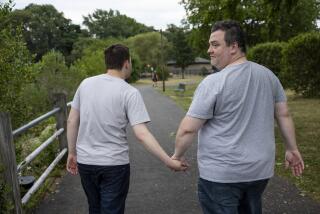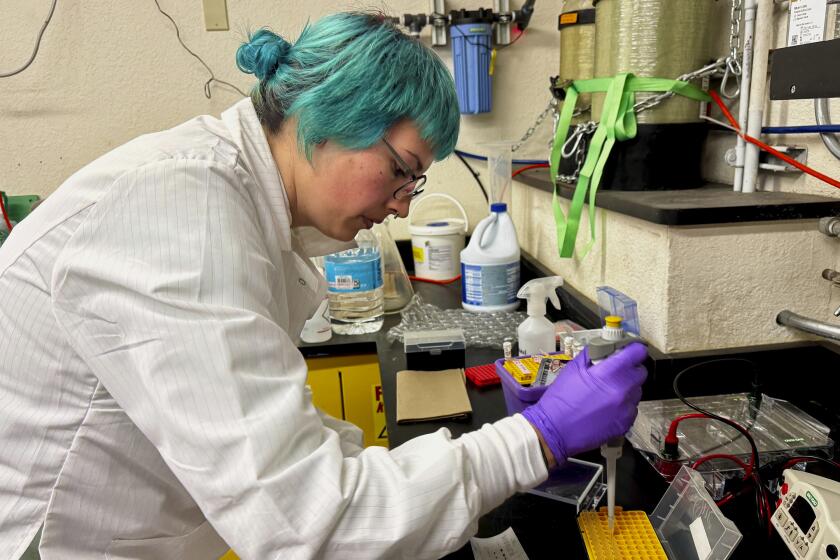Gene Therapy Undergoes a Reevaluation
- Share via
Gene therapy has become a science of irony and unintended consequences.
Through its decades of development, the once-glamorous child of the genetic revolution has faced bad press, lackluster results and a tragic death. Now, fast on the heels of its first-ever success -- and one of its biggest disappointments -- the field is having to reevaluate its use of a principal method of inserting therapeutic genes into cells.
The upheaval has placed new emphasis on a range of experimental strategies that hold great promise but are technically difficult and will take even more time to become useable in the clinic.
Those strategies include ways to control the placement of therapeutic genes so they don’t damage the genome, implement precise DNA repair methods so no new, potentially dangerous genetic information is added to a patient, and create “suicide” genes that are programmed to wipe out genetically altered cells if anything should go wrong.
The cause of the upheaval is one small child. Not long ago, researchers were reveling in the apparent cure of nine French children afflicted with the rare immune system disorder, X-SCID, commonly known as “bubble boy” disease. Then, a few weeks ago, the researchers announced that one of the children has leukemia -- caused, they suspect, by the therapy itself.
Risks that were once only theoretical have become real. Promising strategies that seemed to overcome enormous hurdles may have to be scrapped. Concerns by some scientists and bioethicists that the endeavor has moved too quickly to the clinic have found a more emphatic voice.
“This is definitely an attention-getter, a wake-up call for everybody, and we need more information,” said Dr. Kenneth Weinberg, professor of pediatrics at USC and a physician at Childrens Hospital Los Angeles.
Many scientists still see ultimate promise for the gene therapy. But they cannot predict its fate for the foreseeable future: whether it will be only a niche science for the treatment of the most extreme diseases for which sizable risks are worth taking or, as scientists have long envisioned, a broader strategy for tackling a range of ills, from blindness to baldness.
“At the very best, it looks like this will add years and years to the clinical development of gene therapy,” said Dr. Alan Schechter, chief of the laboratory of chemical biology at the National Institute of Diabetes and Digestive and Kidney Diseases.
Gene therapy is a prospect that has long touched deep nerves among the public and magnified both hope and revulsion, causing unrealistic expectations and extreme reactions when things go wrong.
Scientists too were seduced by its clean logic, often rushing too quickly to make promises of cures and then facing a backlash when trials failed.
“There was the impression among some people that it was going to be rather easy. You have the disease, you put in the gene and correction would be pretty straightforward,” said Dr. Theodore Friedmann, director of the gene therapy program at UC San Diego. “There was too much hype, too much downplaying of the problems.”
Scientists had known for decades that many inherited diseases were because of errors in individual genes. As the genetic revolution gathered momentum -- and scientists learned how to manipulate DNA -- the notion of mending errors no longer seemed fantastic.
Ideally, doctors could correct the genetic error in cells where the gene was required (lung cells, say, in people with cystic fibrosis), leaving the rest of the genome untouched. Such tidy fixes are technically very difficult.
A messier, but easier, strategy is to add a good gene to a cell without getting rid of the faulty one. That’s what scientists do in today’s gene therapy trials, and what was used in the French case.
Getting a gene to its target isn’t easy, so scientists have turned to viruses, which are tailor-made to steal through the body and enter cells. The disease-causing parts of the virus DNA are removed, the therapeutic gene spliced in, and the whole thing wrapped up in the virus coat. Then the hybrid creation is added to the body.
Today, there is a medley of “viral vectors” capable of entering a variety of tissues. Gene therapists pick the ones to suit the disease they’re trying to cure, which today includes everything from inherited diseases to HIV infections and cancers.
For some therapies (such as for cancer), a gene doesn’t have to stay permanently or be passed on to new cells if the original cell divides. In those cases, a virus that efficiently enters cells but eventually dies away fits the bill.
In other cases, such as inherited diseases like cystic fibrosis, a repair has to be permanent. Here, the use of special viruses that insert their genetic material into cells’ genomes ensures that the fix is replicated when cells divide.
Using such methods, researchers have cured mice by the thousands -- of hemophilia and sickle cell disease, of diabetes and cystic fibrosis.
But they have learned, to their pain, that mice are not people.
Thus, it was with great excitement that the field received news of its first human cure of 9 out of 10 young children treated for X-SCID. The trial was led by Dr. Alain Fischer of Necker Hospital in Paris.
For once, the news was not only good but spectacularly so. And so it remained through the summer.
Then came Labor Day weekend, and gene therapists working on similar SCID trials received an upsetting e-mail from Fischer reporting that one of the successfully treated boys had a sickness resembling leukemia.
In response, the U.S. Food and Drug Administration halted four gene therapy trials, although an advisory panel has since recommended that the studies resume.
In a sign of the field’s uncertainty, Britain has opted to continue with its trial for the same disease, while Germany has put a temporary stop to all trials using viruses that insert therapeutic genes into the genome.
“This was the most successful study in the history of gene therapy, so to have one’s worst fears realized in the context of this trial was really upsetting,” said Dr. Donald Kohn, director of the gene, immune and stem cell therapy program at Childrens Hospital Los Angeles and a professor at USC. Kohn is leading one of the gene therapy trials halted by the FDA.
Scientists are still trying to figure out what happened to the child. He may have been at special risk for cancer: Several members of his family had developed a rare brain tumor.
This much is clear: When the viral vector jumped into the genome of one of the boy’s bone marrow stem cells, it apparently disrupted a gene (known as LMO2) that, when altered, can push a cell toward cancer. After several years, cells with that insertion started dividing out of control.
Scientists have long known that something like this could happen because viruses insert themselves into the genome at random sites. There was always the chance that their landing could damage a gene, but only a very small chance because the genome is vast and large swaths of it don’t consist of genes.
Yet in at least one young child, the very unlikely has apparently happened.
Now, scientists must evaluate the chance of it happening again. Researchers suspect that the risks for SCID may turn out to be higher than for other therapies because the viruses insert more frequently into the cells treated in SCID than they do into other kinds of tissues. This might increase the likelihood of a rare, dangerous event.
Gene therapy trials that don’t insert genes into the genome are not directly affected by the French case. But the trials that use such strategies -- about half of the 181 underway in the U.S. -- now face the possibility that random insertion may be too risky.
Dark clouds have blown over the field in the past.
In 1980, a UCLA physician conducted the first gene therapy trial -- overseas, because his university had denied him permission. The trial, to correct an inherited blood disorder, beta-thalassemia, was a scandalous ethics breach that sullied the field from the start.
A chilly cold front moved in during 1995, when the director of the National Institutes of Health roasted the field for skimping on groundwork and hyping the therapy after a string of unsuccessful experiments.
In 1999, a teenage boy died from a violent immune reaction during a gene therapy trial. Afterward, hundreds of other unreported side effects came to light, and noted scientists decried gene therapy’s premature rush to the clinic.
Some say the field never recovered from the succession of errors and ethics breaches.
“Gene therapy is a wheezing, very sick organism,” said Arthur Caplan, chairman of the department of medical ethics at the University of Pennsylvania.
Several scientists said that the gene therapy field has learned hard lessons, and that in the French case, Fischer and the government agencies responded quickly.
Gene therapy supporters believe the field also can overcome the technical hurdles.
“These are all tough problems,” said Inder Verma, professor of molecular biology at the Salk Institute for Biological Studies in La Jolla. “But necessity, you know, is the mother of invention.”
For instance, Stanford University scientists say they’ve figured out a way to shuttle a gene into a cell and have it leap into the genome at only a few, precise places.
The feat is achieved using an enzyme (derived from a bacteria-eating virus) that recognizes particular parts of the genome and guides the DNA to insert at those points. By removing the randomness from insertion, the scientists hope they can render it safe.
They already have shown that their strategy can deliver genes into precise locations in the genome of mice, creating animals that produce a key clotting factor that is missing in many patients with hemophilia.
Scientists also are trying to use viruses that never or rarely jump into genomes, yet hang around in the cell for the long haul. Scientists at Stanford, Children’s Hospital of Philadelphia and Avigen Inc., an Alameda-based biotech company, have treated hemophiliac dogs with a blood-clotting gene spliced into what may be such a viral vector.
Even if genes are inserted into the genome, there are other ways to cut down on risk.
In some trials -- such as the French case -- a patient’s cells are genetically altered in a test tube, and then added back to the body. Theoretically, scientists could screen these cells before returning them, in order to weed out ones with insertions in dangerous places.
Alternatively, a so-called suicide gene could be put in the virus along with the therapeutic gene. If the cell turns rogue -- becomes cancerous, for instance -- scientists can give the patient a drug that will activate the suicide gene, and the rogue cells will then be killed. Such a strategy has proved successful in one gene therapy trial.
But the ideal solution is to perfectly fix a genetic error without introducing any extra DNA, like the deft replacement of a spent battery in a car.
One strategy coaxes the cell to repair the error using tiny pieces of genetic material as guides. Another cuts out the bad part of a gene and stitches in a good piece to replace it.
Both strategies are technically feasible but are years away from the clinic.
Ultimately, researchers say, all the animal experiments in the world won’t prevent unexpected results in people.
Unpredictability is the nature of medical research. Bone marrow transplantation, chemotherapy, vaccine development -- all have hurt and killed people before being assigned to their appropriate medical niche.
“These are early days in the field, but I think it would be foolhardy to concentrate only on the dangers now,” Friedmann said. “We know that patients can be helped.”






